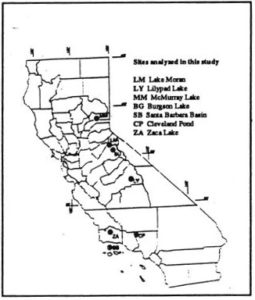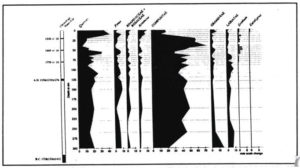Oaks ’n’ Folks – Volume 8, Issue 2 – November 1993
A recent study funded by the IHRMP utilized pollen analysis to reconstruct the structure and abundance of oak woodlands in California on two different time scales: the late Quaternary period covering the last 15,000 years, and the last 500 years spanning the arrival of European settlers. The results from four sites in the Sierra Nevada at the upper elevational limit of oaks provide an opportunity to identify changes in the importance of oaks since the last glaciation, and potentially to identify responses of vegetation to major climatic changes. The record of the last 500 years, based on three low elevation sites in the Coast and Transverse Ranges provides an opportunity to describe oak woodlands prior to Spanish settlement, and identify changes attributable to European impacts. Figure 1 shows the location of the seven study sites.

Oak Distribution in Sierra Nevada Over Last 15,000 Years
Our results in the Sierra Nevada show that oaks became an important component in the montane forest (around 1,800-2,000 meters elevation) beginning around 10,000 years ago. Before that time, our lake sites were surrounded by dense conifer forest. It is difficult to separate the roles of fire and climate; both were important controls on the species composition and density of the regional vegetation. Before 10,0000 years ago, deeper snowpacks persisting into the early summer may have reduced the ecologic impact of summer drought. Low accumulation rates of microscopic charcoal suggest that fires were uncommon and did not burn large quantities of biomass during the interval 12-10,000 years ago. A relatively rapid shift to ponderosa pine-black oak woodland beginning 10,000 years ago may be associated with increasing summer drought stress; all sites show a pronounced increase in charcoal deposits at this time, indicating more intense fires within the region.
At our southern and central sites, Lilypad Lake (LY), Lake Moran (LM) and Burgonson Lake (BU), open woodland conditions persisted from about 10-5,000 years ago. Oaks at these sites were associated with understory species characteristic of open, seasonally dry conditions. We attribute the oak pollen signal to a combination of California black oak (Quercus kelloggii), the only common tree oak at these elevations, and shrub species such as Q. vaccinifolia, huckleberry oak. After about 5,000 years B.P., oak decreased in abundance, giving way to pines and firs. Shifts in oak and understory pollen types are less pronounced at our northernmost site, McMurray Lake, than at the other Sierran locations.
Oak Distribution in Coast and Transverse Ranges Over Last 500 Years
Results from the three study sites in the Coast and Transverse Ranges suggest that prior to European settlement, populations of oaks did not vary significantly, but remained at a relatively constant level. However, over about the last century, woodlands have markedly increased in oak density. The fossil record clearly shows that European settlement has had a profound effect on California oaks. However, contrary to general concerns, this effect has led to an increase in oak abundance at two of the three sites. We believe that changes in fire frequency, primarily associated with suppression efforts, increased development, and changes in land use practices around the turn of the century, have played an important role in increasing woodland densities. The ecologic response of oak woodlands to recent environmental changes varies by species and location.
Coast live oak at our low elevation coastal site, the Santa Barbara Basin (SB), shows an increase in the last century and woodlands appear to be more dense than during the pre-European period. This trend is confirmed by ecologic studies which have found that in recent times, coast live oak woodlands have increased in density, largely as a result of protection from fire. The success with which coast live oak can regenerate under its own canopy, and survive the absence of fire suggests that even in the southern portion of its range where regeneration rates are lowest, this species benefits from current management practices.
At Zaca Lake (ZA), an upper elevation site where coast live oak interfingers with conifers, the pollen record clearly shows that pines increased substantially in the last century and are succeeding oaks. Under present management it appears that pines are expanding downslope into areas once dominated by more open oak woodlands.

The pollen record for blue oaks, represented by Cleveland Pond (CP), is less clear, but by combining our data with age structure studies we conclude that blue oak woodlands were more open during pre-European period and have increased in density during the last century. Figure 2 shows an example of a pollen percentage graph for the nine dominant plant species at this site over the last 3,500 years. This shows the pollen record remained fairly constant prior to the arrival of the genus Erodium, after which considerable fluctuations can be seen, particularly in Compositae and oak pollen percentages. Oak pollen percentage was fairly constant between 1728 B.C. to 1830 A.D. At the 65 cm. level, corresponding approximately to 1830, oak raises to 31 percent of the pollen. This then declined sharply, to a low of 6 percent of the pollen sample, reached around 1880. Following this decline in oak abundance, oak pollen percentage rose substantially, reaching its highest level (43 percent) around 1960. Oak pollen percentage remains high today at this site (around 34 percent). The oak signal in these cores most likely represents blue and valley oak, the dominant trees in the region, with some contribution from other species.
The increase in the density of oaks at the Cleveland Pond site is an artifact of high rates of recruitment and survival which occurred in the nineteenth century. The present conditions do not support blue oak recruitment, and regeneration is largely absent in these woodlands today. Current lack of regeneration is likely due to soil moisture competition, continued livestock grazing, and intraspecific competition from the highest blue oak density over the 3500 years.
Conclusions
Shifts in oak abundance over the past 15,000 years provide a baseline by which to gauge present-day management issues. In the Sierran montane forest zone, oaks were generally more abundant 10,000 to 5,000 years ago than they are today. This pattern of distribution was tied to increased fire intensity and a climate in which summer droughts may have been more intense on average than those experienced in the historic period.
Our findings suggest that efforts to assess the current regeneration of oak woodlands around the state cannot begin with the assumption that the current population is the result of long term natural regeneration processes. We found that woodland density has increased as a result of European impacts. Studies from oak woodlands in other parts of the state have suggested similar results. The oak woodlands present in California today are not simply the result of ongoing natural processes, but are an artifact of changes introduced by European settlers. Current low regeneration rates may in part be a response to past periods of over-recruitment, although we recognize that the process is very complicated.
Since major changes in oak woodlands have occurred during the last century, further research which identifies regeneration pulses during the last 100-200 years would be particularly useful. To date, only a handful of age structure studies have been conducted. Additional tree ring studies would clarify recent recruitment history and provide a better basis for determining regeneration status. Further pollen studies in the northern part of the state would increase our understanding of the responses of oak woodland to European impacts.
Roger Byrne
Scott Mensing
Eric Edlin
UC Berkeley,
Geography Department
prepared and edited by John M. Harper, Richard B. Standiford, and John W. LeBlanc
